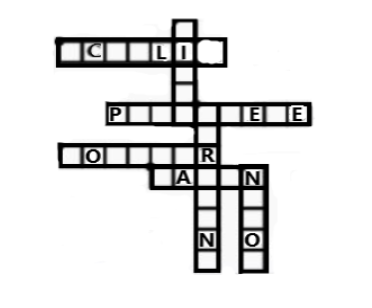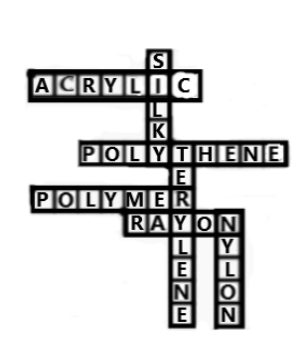
Complete the crossword given below with the help of clues.
Substance made up of large number of smaller molecules (7)


Answer
557.7k+ views
Hint: As we know that substances that are made up of a large number of small molecules are called polymers, these are composed of repeating subunits of small molecules. They can be natural and synthetic as well.
Complete Step by step answer: As we know that polymers are made up of large molecules having monomeric repeating smaller units and hence are also called macromolecules. On the basis of sources they can be classified into natural, synthetic and semi-synthetic polymers. Natural polymers are found in plants and animals like proteins, cellulose etc, synthetic polymers are man-made and used in daily life like polythene and semi-synthetic polymers are the one that are obtained from natural polymers like cellulose acetate.
In the given puzzle the first polymer is Acrylic which is a type of synthetic fibre obtained by polymerisation of polyacrylonitrile and is commonly used in sweater and tracksuits making. Second one is silk polymer which is made up of folded linear polymer layers and it is also a type of synthetic polymer. Next comes polythene which is obtained by the addition polymerisation of ethene monomers and is a homopolymer commonly used in making plastic bags.
Then comes terylene which is an artificial fibre obtained from ethylene glycol and terephthalic acid and commonly used in making light, bed-linen, sails etc. Then Rayon which is commonly called cellulose acetate and is made from cellulose hence it is a semi-synthetic polymer.
And lastly the nylon which is also a synthetic polymer and a thermoplastic that can be used in making fibres, films and shapes of materials. It is obtained from condensation of hexamethylenediamine with adipic acid and by heating caprolactam with water at high temperature.
Therefore, the complete crossword is:

Note: Polymers are the base for plastic, textile and glass industries as polymers do no melt but they change their state from crystalline to semi-crystalline and as the monomeric chain increases to make a large molecule the tensile strength of the polymer increases.
Complete Step by step answer: As we know that polymers are made up of large molecules having monomeric repeating smaller units and hence are also called macromolecules. On the basis of sources they can be classified into natural, synthetic and semi-synthetic polymers. Natural polymers are found in plants and animals like proteins, cellulose etc, synthetic polymers are man-made and used in daily life like polythene and semi-synthetic polymers are the one that are obtained from natural polymers like cellulose acetate.
In the given puzzle the first polymer is Acrylic which is a type of synthetic fibre obtained by polymerisation of polyacrylonitrile and is commonly used in sweater and tracksuits making. Second one is silk polymer which is made up of folded linear polymer layers and it is also a type of synthetic polymer. Next comes polythene which is obtained by the addition polymerisation of ethene monomers and is a homopolymer commonly used in making plastic bags.
Then comes terylene which is an artificial fibre obtained from ethylene glycol and terephthalic acid and commonly used in making light, bed-linen, sails etc. Then Rayon which is commonly called cellulose acetate and is made from cellulose hence it is a semi-synthetic polymer.
And lastly the nylon which is also a synthetic polymer and a thermoplastic that can be used in making fibres, films and shapes of materials. It is obtained from condensation of hexamethylenediamine with adipic acid and by heating caprolactam with water at high temperature.
Therefore, the complete crossword is:

Note: Polymers are the base for plastic, textile and glass industries as polymers do no melt but they change their state from crystalline to semi-crystalline and as the monomeric chain increases to make a large molecule the tensile strength of the polymer increases.
Recently Updated Pages
Why are manures considered better than fertilizers class 11 biology CBSE

Find the coordinates of the midpoint of the line segment class 11 maths CBSE

Distinguish between static friction limiting friction class 11 physics CBSE

The Chairman of the constituent Assembly was A Jawaharlal class 11 social science CBSE

The first National Commission on Labour NCL submitted class 11 social science CBSE

Number of all subshell of n + l 7 is A 4 B 5 C 6 D class 11 chemistry CBSE

Trending doubts
10 examples of friction in our daily life

One Metric ton is equal to kg A 10000 B 1000 C 100 class 11 physics CBSE

Difference Between Prokaryotic Cells and Eukaryotic Cells

1 Quintal is equal to a 110 kg b 10 kg c 100kg d 1000 class 11 physics CBSE

State the laws of reflection of light

Explain zero factorial class 11 maths CBSE




